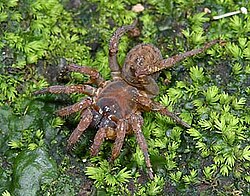| Heptathelinae | |
|---|---|

| |
| Heptathela kimurai | |
| Scientific classification | |
| Kingdom: | Animalia |
| Phylum: | Arthropoda |
| Subphylum: | Chelicerata |
| Class: | Arachnida |
| Order: | Araneae |
| Suborder: | Mesothelae |
| Family: | Liphistiidae |
| Subfamily: | Heptathelinae Kishida, 1923 |
| Genera | |
Heptathelinae is a subfamily of spiders in the family Liphistiidae, the only extant family in the suborder Mesothelae. It has been treated as the separate family Heptathelidae.[1][2] As of November 2025[update], merging Heptathelidae into Liphistiidae is accepted by the World Spider Catalog.[3] The suborder Mesothelae contains the most basal living spiders.
Taxonomy
[edit]The group was first proposed by Kyukichi Kishida in 1923, when he described a new genus, Heptathela, and suggested creating two tribes within the family Liphistiidae, with Heptathela placed in Heptatheleae.[4] In 1939, Alexander Petrunkevitch raised the tribe Heptatheleae to a separate family, Heptathelidae. In 1985, Robert Raven reunited the two families,[5] a view supported by Breitling in 2022.[6] Other authors have maintained two separate families,[2][7] a position previously accepted by the World Spider Catalog, but rejected as of November 2025[update].[3] When not treated as separate families, the two groups are treated as subfamilies of the family Liphistiidae: subfamily Liphistiinae, containing only the genus Liphistius, and subfamily Heptathelinae.[1]
Phylogeny
[edit]Molecular phylogenetic studies have repeatedly shown that the group is monophyletic, whether treated as a subfamily or a family.[8][1] One possible relationship between the genera is shown in the following Bayesian cladogram from a 2023 study (numbers in parentheses give the number of units in the study):[9]
|
China, Vietnam
Japan, including Okinawa, and the Ryukyu Islands |
Genera
[edit]As of November 2025[update], seven genera were accepted, other than Liphistius, which is placed in the subfamily Liphistiinae.[10][1][11]
- Ganthela Xu & Kuntner, 2015
- Heptathela Kishida, 1923
- Luthela Xu & Li, 2022
- Qiongthela Xu & Kuntner, 2015
- Ryuthela Haupt, 1983
- Songthela Ono, 2000
- Vinathela Ono, 2000
The genus Sinothela is considered a nomen dubium (dubious name).
-
Burrow of Heptathela kimurai
Description
[edit]Members of the Heptathelinae share features with the Liphistiinae. They are medium to large spiders. They have downward pointing, daggerlike chelicerae.[12] Like other members of the suborder Mesothelae, and unlike all other extant spiders, they have a segmented series of plates (tergites) on the upper surface of all segments of the abdomen and their spinnerets are placed in the middle of the underside of the abdomen, rather than at the end. Their sternum (a plate on the underside of the cephalothorax) is narrow, and there is another smaller ventral plate (the sternite) between the fourth pair of legs. They respire by means of two pairs of book lungs. Unlike members of the Liphistiidae, the palp of the male lacks a tibial apophysis.[13]
They live in burrows closed by trapdoors. Unlike members of the Liphistiinae, heptathelines do not construct signal lines radiating from the burrow.[13]
References
[edit]- ^ a b c d Sivayyapram, Varat; Kunsete, Chawakorn; Xu, Xin; Smith, Deborah R.; Traiyasut, Prapun; Deowanish, Sureerat; Li, Daiqin & Warrit, Natapot (2024), "Molecular phylogeny, biogeography, and species delimitation of segmented spider genus Liphistius (Araneae: Liphistiidae) in Thailand", Zoological Journal of the Linnean Society, 201 (2): 339–357, doi:10.1093/zoolinnean/zlad149
- ^ a b Li, S.Q. (2022), "On the taxonomy of spiders of the suborder Mesothelae", Acta Arachnologica Sinica, 31 (1): 71–72, doi:10.3969/j.issn.1005-9628.2022.01.013 – via World Spider Catalog
- ^ a b "Family: Heptathelidae Kishida, 1923", World Spider Catalog, Natural History Museum Bern, retrieved 2025-11-02
- ^ Kishida, K. (1923), "Heptathela, a new genus of liphistiid spiders", Annotationes Zoologicae Japonenses, 10: 235–242 – via World Spider Catalog
- ^ Raven, R. J. (1985), "The spider infraorder Mygalomorphae (Araneae): cladistics and systematics", Bulletin of the American Museum of Natural History, 182: 1–180 – via World Spider Catalog
- ^ Breitling, R. (2022), "On the taxonomic rank of the major subdivisions of the extant segmented spiders (Arachnida: Araneae: Mesothelae: Liphistiidae s. lat.)", Miscellanea Araneologica, 2022: 1–4 – via World Spider Catalog
- ^ Kulkarni, S.; Wood, H. M. & Hormiga, G. (2023), "Advances in the reconstruction of the spider tree of life: a roadmap for spider systematics and comparative studies", Cladistics, 39 (6): 479–532, doi:10.1111/cla.12557, PMID 37787157
- ^ Xu, Xin; Liu, Fengxiang; Cheng, Ren-Chung; Chen, Jian; Xu, Xiang; Zhang, Zhisheng; Ono, Hirotsugu; Pham, Dinh Sac; Norma-Rashid, Y.; Arnedo, Miquel A.; Kuntner, Matjaž & Li, Daiqin (2015). "Extant primitively segmented spiders have recently diversified from an ancient lineage". Proceedings of the Royal Society B. 282 (1808) 20142486. doi:10.1098/rspb.2014.2486. PMC 4455790. PMID 25948684.
- ^ Wei, M.; Wang, S. Q. & Lin, Y. C. (2023), "Systematic notes on three new Luthela (Mesothelae, Heptathelidae) spiders from China, with their descriptions", ZooKeys (1159): 151–168, Bibcode:2023ZooK.1159..151W, doi:10.3897/zookeys.1159.90120
- ^ "Family Liphistiidae Thorell, 1869 (genus list)", World Spider Catalog, Natural History Museum Bern, retrieved 2025-11-02
- ^ Xu, Xin; Su, Yong-Chao; Ho, Simon Y. W.; Kuntner, Matjaž; Ono, Hirotsugu; Liu, Fengxiang; Chang, Chia-Chen; Warrit, Natapot; Sivayyapram, Varat; Aung, Khin Pyae Pyae; Pham, Dinh Sac; Norma-Rashid, Y. & Li, Daiqin (2021), "Phylogenomic Analysis of Ultraconserved Elements Resolves the Evolutionary and Biogeographic History of Segmented Trapdoor Spiders", Systematic Biology, 70 (6): 1110–1122, doi:10.1093/sysbio/syaa098
- ^ Haupt, J. (2004), "The Mesothelae - a monograph of an exceptional group of spiders (Araneae: Mesothelae)", Zoologica, 154 (8), ISBN 3-510-55041-2, ISSN 0044-5088
- ^ a b Xin, Xu; Liu, Fengxiang; Chen, Jian; Ono, Hirotsugu; Li, Daiqin & Kuntner, Matjaž (2015-03-21), "A genus-level taxonomic review of primitively segmented spiders (Mesothelae, Liphistiidae)", ZooKeys (488): 121–151, Bibcode:2015ZooK..488..121X, doi:10.3897/zookeys.488.8726, PMID 25878527

